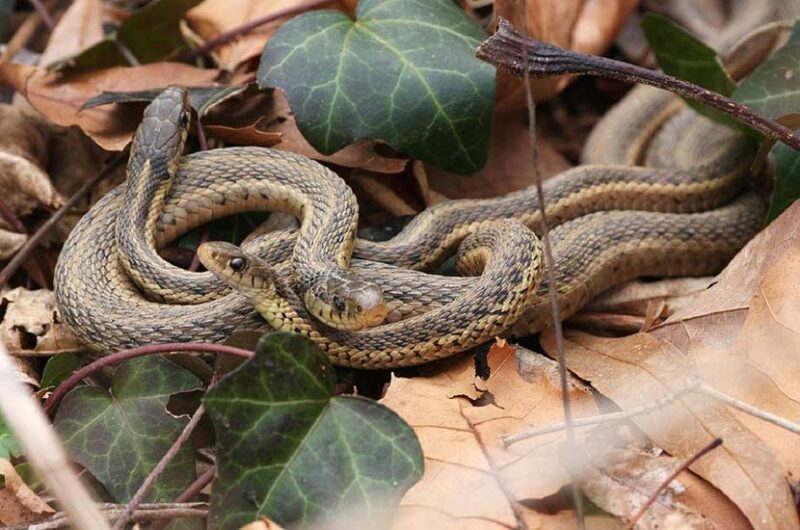Erica Mede, CVT
Description
Garter snakes are shy snakes reaching lengths of 2-3 feet. With a life span of 10-12 years, these snakes are common in captivity and are exceptional escape artists. There are various species of Garter snake available in the reptile industry and a plethora of morphs (color variations) as well! Hatchlings are about 4-5 inches long. These snakes are generally patterned with full length stripes starting behind the head and progressing down the body with large round eyes and slender bodies. Garter snakes are diurnal and terrestrial, sporting the classic round pupils that most people associate with “safe” snakes. When startled, these snakes will often mimic rattling by vibrating their tail quickly and when all else fails, musk their captors with a fluid that leaves the captor smelling unpleasant. These snakes are great swimmers as well and agile low level branch climbers.
Natural History
These diurnal, terrestrial semi-aquatic snakes are found throughout the United States and portions of Canada in fields, forests, wetlands, marshes, and residential areas. This species of snake does brumate during the winter months in large masses. Generally, before exiting the brumation den, these snakes will breed.
Enclosure
Up to three adults can easily be kept in a 20-30 gallon glass aquarium with a screen lid. It is recommended to house they animals alone for the best monitoring capabilities but if a group housing situation is desired, two females and a male or all females is acceptable. The larger the cage and the wider the cage the better! Wider enclosures allow for more exercise and fulfill this species urge to explore. Custom designed enclosures can be created but are not commonly utilized in the pet industry. However, custom enclosures created with a little ingenuity and imagination can offer supreme naturalistic set-ups. Hatchlings can be kept in 10 gallon aquariums.
Substrate
Substrate should be easy to clean and dry. Newspaper, reptile carpet, and paper towel are favorites for hatchlings and new individuals to help monitor fecal output. Most established individuals can be maintained happily on the above or aspen shavings as long as it is agitated frequently and changed every 7-14 days. Never use pine or cedar shavings which have aromatic oils that can cause irritation and respiratory issues in snakes. Enrichment can be provided by placing hay, straw, or even dried leaves in the cage for the snake to explore and navigate through.
Temperature and Humidity
Garter snakes require an ambient temperature of 75-85F° which is easily provided with under tank heaters, heat tape, heat cable (on the outside of the cage not the inside). The temperatures can be controlled easily with a thermostat and monitored with the use of three thermometers. One thermometer placed on the warm end an inch above the substrate, one placed at the level of the basking site, and another placed an inch above the substrate on the cooler end. A basking site should be 85-88F°. At night, the temperature can drop as low as 72F°.
Humidity should be moderate, 35-60%, with the higher end utilized during shedding. Humidity can be monitored with a hygrometer and increased with the use of a large water bowl, fogger, mister, or daily spraying.
Enrichment
Low branches for climbing should be offered to Garter snakes for exercise and increased basking sites. Garter snakes will climb low branches but are not excellent climbers so it is important not to have the branches at severe angles. Natural and artificial foliage can be placed in the cage to increase hiding locations. Hide boxes in the form of half logs, PVC pipes, and half flower pots can be utilized. Rocks can be added especially for basking areas if they are placed over a heat source and under the basking light to warm the rock. A large water bowl is highly recommended to allow the snake to soak at will and swim. Small plastic storage containers make excellent “swimming pools” for this species and does not require a heater. If a custom enclosure is created with a custom pond situation then a filter system and heating element may be needed.
Feeding
In the wild, these snakes feed primarily on small rodents, fish, earthworms, and slugs. In captivity, these snakes are fed primarily earth worms, fish, and/or mice. It should be noted that snakes fed primarily earthworms must be fed more at least two times a week while fish eaters and mice eaters should be fed every 7 days. It is recommended that only pre-killed prey be offered as live prey has the potential of severely injuring or killing captive snakes in the case of mice and can transmit parasites in the case of fish. Chicago Exotics recommends feeding properly thawed frozen rodents. Hatchlings can be fed every 3-5 days depending on diet offered. Juveniles and adults every 4-7 days depending on diet offered. A word of caution against feeding night crawlers from bait shops, these large powerful worms are very difficult for these snakes to eat. If night crawlers are to be offered, it is strongly recommended to cut these worms into pieces first.
Owners wishing to feed mice to their Garter snakes may find it frustrating when some individuals simply refuse to eat them. Not all will. Scenting mice by rubbing them on fish or earthworms seems to help but is not always successful. Very small snakes should be fed pinky mouse parts as they cannot eat a whole mouse. Adult snakes typically can eat hopper mice or fuzzies.
Sources and Recommended Reading
Garter and Ribbon Snakes, R. D. Bartlett and Patricia Bartlett
The General Care and Maintenance of Gater Snakes and Water Snakes, David Perlowin
The Garter Snakes: Evolution and Ecology, D. Rossman, N.B. Ford, R.A. Siegel
An educational handout concerning reptiles and Salmonella is available through the Association of Reptilian and Amphibian Veterinarians. Please ask your veterinarian for a copy.
If you have any questions, please feel free to call us at (502) 241-4117.

